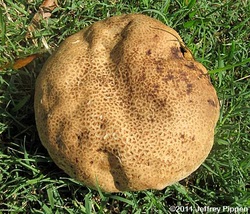- Home
- Mushrooms - why?
- Chaga mushroom - medicinal
- Red reishi - medicinal
- Chicken mushroom – food
- Puffballs - food
- Maitake mushroom - medicinal
- Chanterelle mushroom - food
- Lobster mushrooms - food
- Honey mushrooms -food
- Shiitake mushroom – medicinal and food
- Morels - food
- Oyster Mushrooms - medicinal and food
- Common poisonous mushrooms in NC
- How to grow oyster mushrooms at home
- Blog
Puffball mushrooms

Puffballs can be freakishly giant or the size of
a common button mushroom found in the grocery store. They have a bulbous cap and
the beginners should stick to specimens larger than a fist. Puffballs do not
have a stem. They are smooth and white on the inside and range in color from
brown to white on the cap. Puffballs are often found growing around fallen trees
and lawns. They grow throughout the spring but fruit the most during the
fall.
Puffball mushrooms, Calvatia gigantea, are the only mushrooms that contain all of its spores inside its fruiting body.
All members of the true puffball species are edible only when young with a white flesh. Mature puffballs
decompose quickly and become dangerous to eat.
Puffball mushrooms' given name is a precursor to how they appear. They are roughly rounded with a white, warted leathery exterior. When young their interior is spongy and white, with a texture and flavor similar to
tofu. Mature, giant Puffballs' skin begins to brown and their flesh will become yellow green to brown, a signal that the mushrooms are inedible.
Puffballs are most often prepared as a side dish or entree accompaniment. Their flavor and texture are enhanced when battered and fried, as tempura or sauteed. Pair with cow's milk cheeses, tomatoes, peppers or asparagus. Use soy, ginger, garlic, chili or mirin to complement the flavor of Puffball mushrooms. Dried puffballs may be substituted for tofu. To store, place unwashed mushrooms in a paper bag or between paper towels; refrigerate. Do not store in plastic. Do not soak Puffballs in water.
a common button mushroom found in the grocery store. They have a bulbous cap and
the beginners should stick to specimens larger than a fist. Puffballs do not
have a stem. They are smooth and white on the inside and range in color from
brown to white on the cap. Puffballs are often found growing around fallen trees
and lawns. They grow throughout the spring but fruit the most during the
fall.
Puffball mushrooms, Calvatia gigantea, are the only mushrooms that contain all of its spores inside its fruiting body.
All members of the true puffball species are edible only when young with a white flesh. Mature puffballs
decompose quickly and become dangerous to eat.
Puffball mushrooms' given name is a precursor to how they appear. They are roughly rounded with a white, warted leathery exterior. When young their interior is spongy and white, with a texture and flavor similar to
tofu. Mature, giant Puffballs' skin begins to brown and their flesh will become yellow green to brown, a signal that the mushrooms are inedible.
Puffballs are most often prepared as a side dish or entree accompaniment. Their flavor and texture are enhanced when battered and fried, as tempura or sauteed. Pair with cow's milk cheeses, tomatoes, peppers or asparagus. Use soy, ginger, garlic, chili or mirin to complement the flavor of Puffball mushrooms. Dried puffballs may be substituted for tofu. To store, place unwashed mushrooms in a paper bag or between paper towels; refrigerate. Do not store in plastic. Do not soak Puffballs in water.
